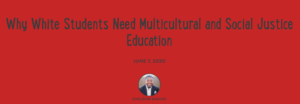As school’s wrap up the student experiences of their Remote Learning Plans, there is much to reflect upon. How have students survived, thrived or not? How have students learned more about themselves as learners, and how do we know?
The same can be asked of our organizations. This week, during the CIS Ontario Remote Learning conversations, I was moderating a panel of great educators discussing “What is your approach to planning for next academic year?” Notice, the question was not “What are you planning for next year?”. The question being asked was very deliberate – what mindsets, what frames of thinking and what considerations? Not what is your timetable, what is your tech?
To this end, the three resources I’ve loved this week have helped me consider how schools as organizations and as institutions might approach their planning for next year.
1. TECHLASH – Issue 01 CLICK HERE
In this publication, the first issue, the authors address the sticky issue of how might COVID-19 be misused to force radical educational reforms by those that stand to benefit directly from these reforms. This is a provocative read that was brought to me by Mary-Lou O’Brien – a fantastic Aussie Digital Transformation Consultant.
COVID-19 be misused to force radical educational reforms by those that stand to benefit directly from these reforms. This is a provocative read that was brought to me by Mary-Lou O’Brien – a fantastic Aussie Digital Transformation Consultant.
This resource asks us to consider the decisions we are making – the long term implications of the digital designs of our classrooms and pedagogical choices.
“Indeed, the COVID-driven pivot to temporary remote home-schooling could be reframed as a moment where a wide range of publics are now well-attuned to the social limitations of educational technologies when used in situ.”
2. Spacing: Make Civic Skills the new Coding CLICK HERE
Thanks to Josh Fullan of Maximum City and of UTS for this provocation! I could quote this whole article it is that rich in making me think about how we view the world pre and post Covid-19, and how we can attune ourselves and our students to what is come and what we have learned.
COVID-19 has transformed what it means to live in cities. While its
long-tail effects on urban life are largely uncertain, one thing is clear in the short term: navigating the local community will be different and more consequential. As our social physics get redrawn into tighter and less random patterns, our daily hyper local interactions will become more frequent and fraught. The trip to the store, the walk to the park, the visit to the recreation centre, will all come with a new set of written and unwritten rules. How these rules get codified and respected is partly up to governments, and partly up to us as urban citizens. How much advocacy, engagement and civic sweat equity we are willing to invest?
What is it that we want our students to notice about themselves and their surroundings? What inequities, what beauty and what learnings have surfaced that impact our identity and how we engage in the world? And, now, how will be integrate this into the planning for next year?
3. Listen to The Cult of Pedagogy: Why White Students Need Multicultural and Social Justice Education CLICK HERE
 Powerful lessons and provocations on why we must integrate multicultural andsocial justice education into our schools. As we plan for next year, approaching it through the lens of social justice will do nothing but deepen and extend the learning that happens for all within the school.
Powerful lessons and provocations on why we must integrate multicultural andsocial justice education into our schools. As we plan for next year, approaching it through the lens of social justice will do nothing but deepen and extend the learning that happens for all within the school.
But multicultural education is about more than just race: It refers to any form of learning or teaching that incorporates the histories, texts, values, beliefs, and perspectives of people from different cultural backgrounds (Glossary of Education Reform). And even if the majority of your students are White, it doesn’t mean we shouldn’t teach from a multicultural perspective.
And,
Having literacy in this area is also key for equipping White students to participate more actively in conversations about racial justice. If they are not regularly exposed to these conversations, they are less likely to speak up on this topic. White friends and colleagues tell me all the time that they want to say something when racism and equity come up, but they often hold back because they don’t know what to say or are afraid to say the wrong thing. With a higher level of multicultural literacy, our students will build more confidence.
As we plan for next year, having a macro-language, shared understanding and a developmental approach to social justice work is a powerful consideration.
We are involved in the creation of a new type of learning. Let’s not waste this opportunity by jumping in too quickly. Pause and think – Go slow to move quickly – and consider approaches first before you consider planning.
Embrace this opportunity to solidify your organization as a learning organization.
